Light, Flaky Pie Crust with Lard and Butter
Make the best ever pie crust with lard and butter. The result is the tender, flaky and buttery pie crust of your dreams. This foolproof lard pie crust recipe uses a good quality leaf lard and butter with an egg & vinegar mixture. It’s simply the best!
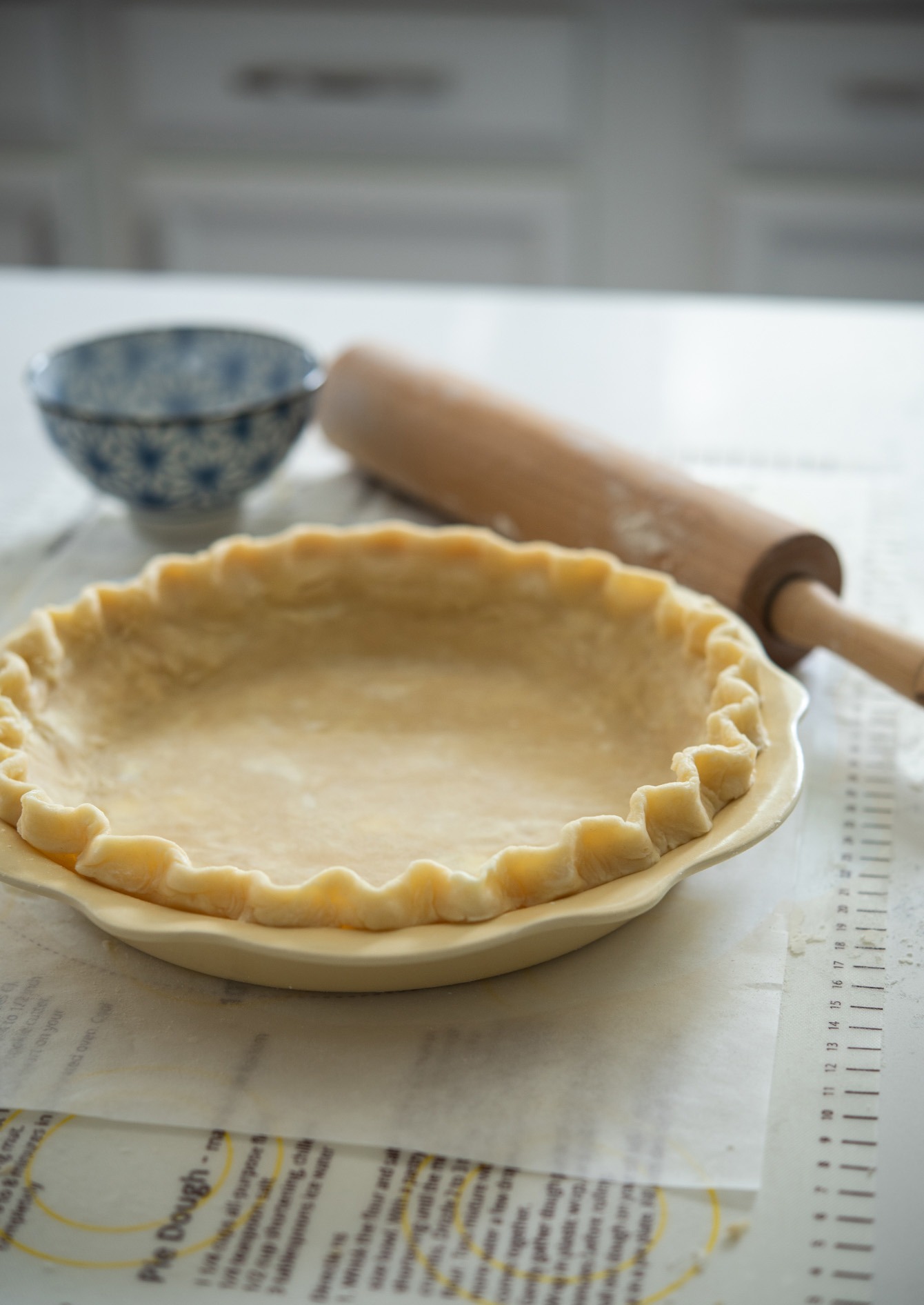
“This recipe is awesome! I have always made Pioneer Woman’s pie crust and they don’t compare. This recipe is definitely more flaky and the tasty. This will be my pie crust recipe I will use forever.”
DENISE
If you love making homemade pies, like the all-American classic deep dish apple pie or pecan pie, a flaky homemade pie crust makes all the difference no matter what filling goes into the crust. This light, tender, flaky, and buttery pie crust is always a sure winner.
People use different kinds of fat to make their pie dough – butter, shortening, lard, or even oil.
Many use an all-butter option for the buttery flavor but, for a pie crust, I found it lacks flakiness. (But I do like all butter in tarts and galettes.)
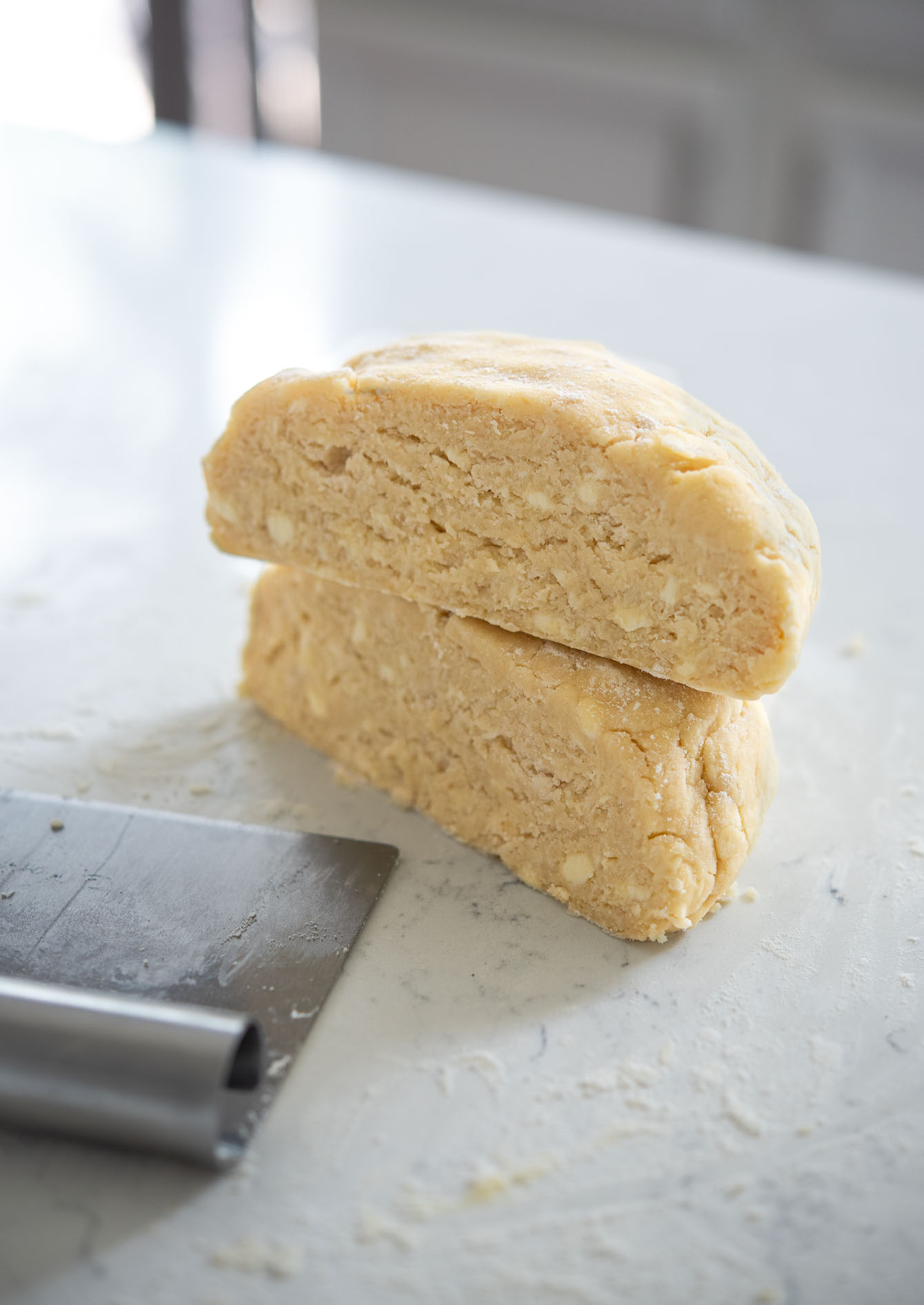
I used to make my pie dough with half butter and half shortening to get a flaky texture with some buttery flavor. The result is fine.
Then I discovered lard, especially “Leaf Lard.”
Now I use half butter and half leaf lard for my pie dough and I couldn’t be any happier with the outcome. I got the light, flaky, and buttery pie crust that I ever dreamed of.
This is a perfect pie crust recipe and it’s foolproof. I don’t think you can get any better lard pie crust than this one.
What is Leaf Lard?
Leaf lard is rendered leaf fat from near the pig’s kidney and loin. It is known for being lower in saturated fats than butter and higher in monounsaturated fats, which is better for cardiovascular health. Leaf lard is considered the highest grade of lard you can get from any pork fat.
Why “leaf”? Because the mass of fat resembles the shape of a leaf after it’s rendered.
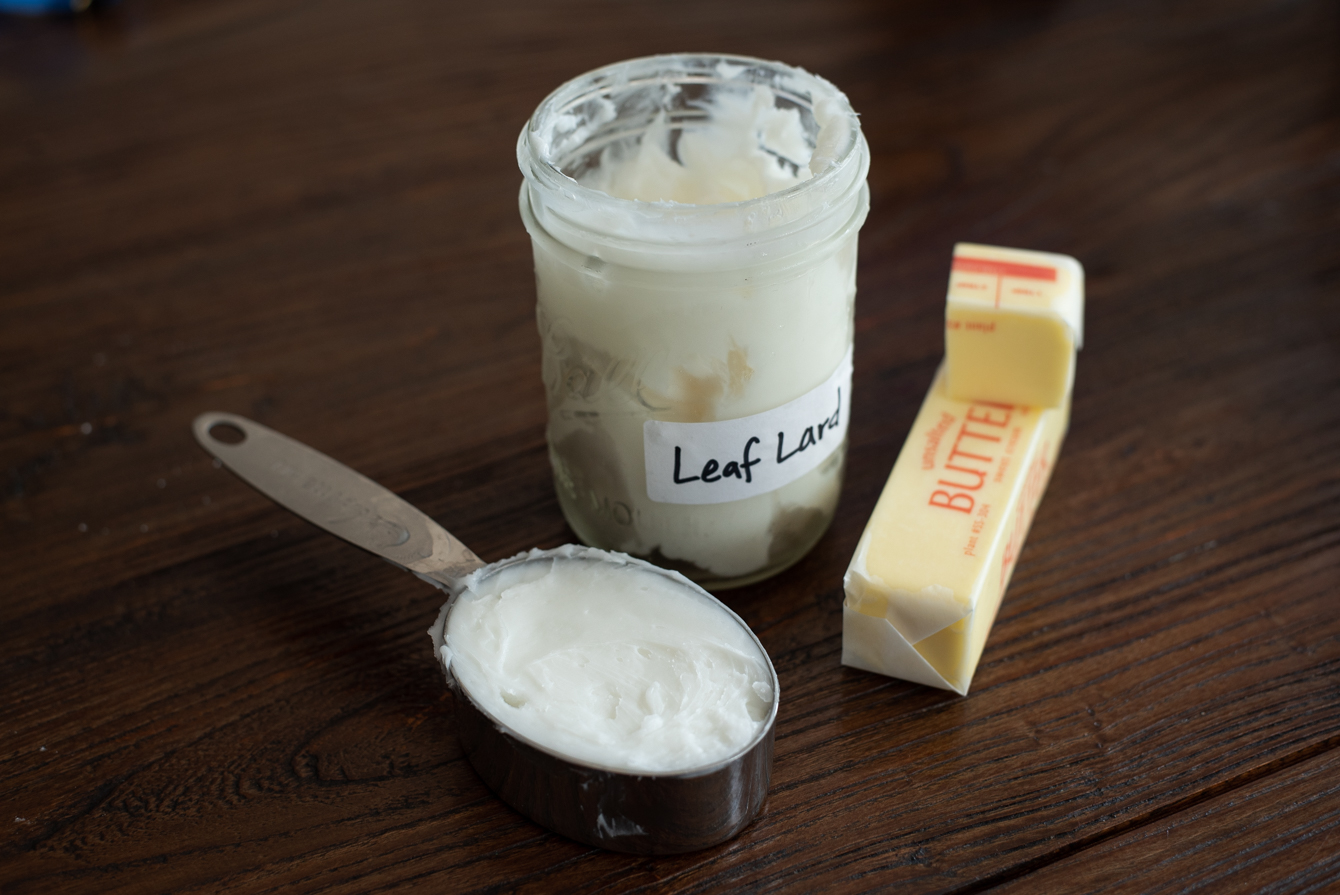
Where to find Leaf Lard: You can get leaf lard from your local butcher shops or farmer’s markets. Online stores like Amazon or Etsy also sell bottled leaf lard. I got mine from a place called Fannie & Flo. They have different types of old-fashioned fats.
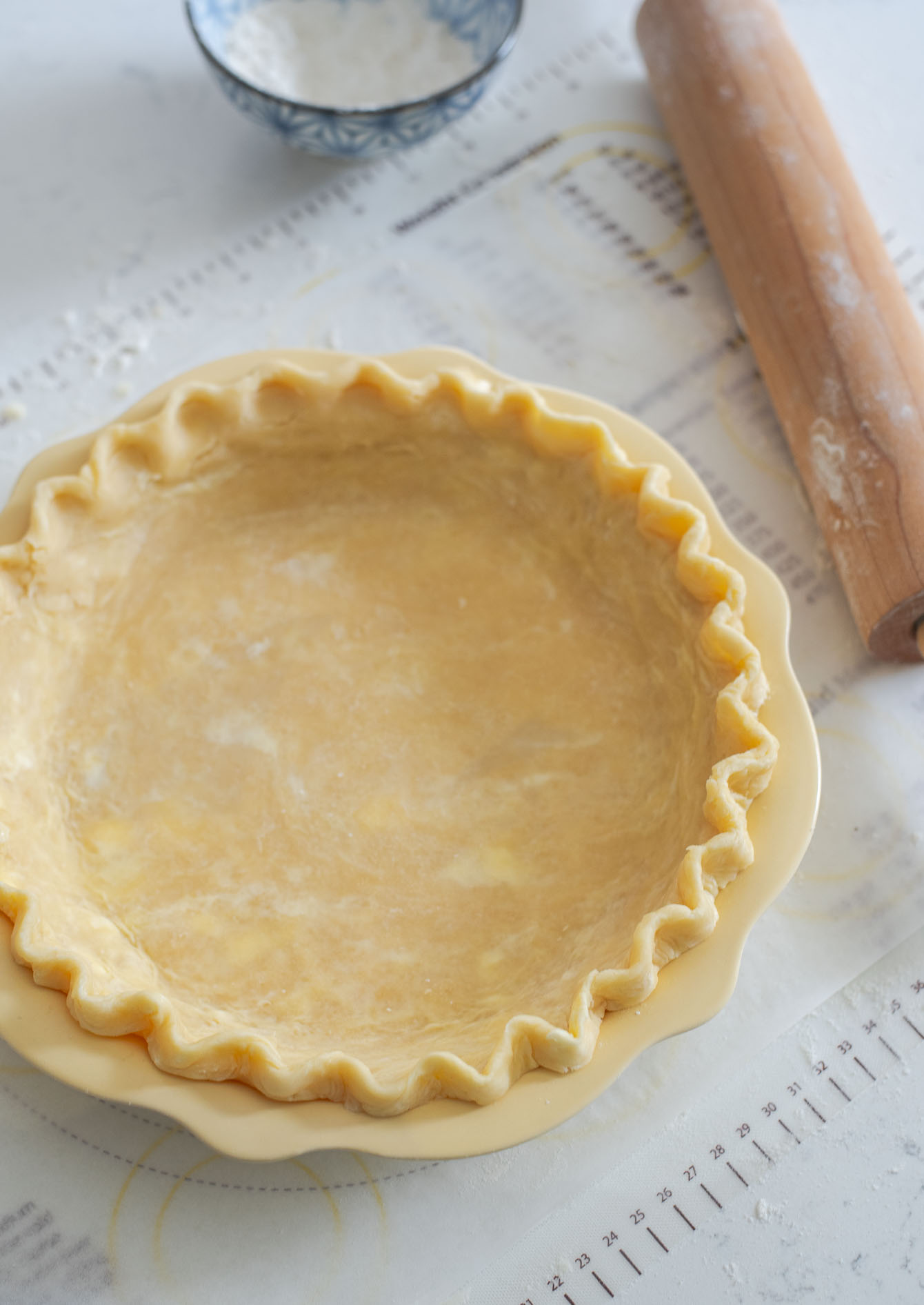
Tips for Making Flaky Pie Crust
- Cold temperature: Cold temperature fats, flour, egg, water (ice water) keeps the pie dough cold and easy to work with.
- Pie crust with egg and vinegar: The trick to make pie crust light and flaky on top of lard and butter is using a mixture of egg and vinegar. Egg makes the dough more pliable and easy to roll out. Pie crust with vinegar has been a well kept secret for many avid bakers for a tenderer and flakier pie.
- Chill the pie dough before you roll out: Chilling hardens the fat in the dough, and helps maintain its structure as it bakes. It relaxes the dough’s gluten and prevents a tough crust.
- Work fast when you roll out the crust: If rolling out takes too long, the fats will start to loosen and the crust will become sticky. You want to work fast as you roll out the dough to maintain the cold temperature.
- Keep pie crust chilled: It is recommendable to chill the rolled and fluted crust in a pie pan in the fridge before adding the pie filling. Chilled crust holds its fluted shape better.
Ingredients for Lard and Butter Pie Crust
- All-purpose flour
- Cornstarch (optional): Adding a little bit of cornstarch will lighten up the texture of crust. You can leave it out if you prefer heavier crust texture.
- Salt: A hint of salt balances the flavor.
- Leaf Lard or lard: Simply the best fat for making pie crust. Use the best quality you can find.
- Butter (unsalted butter): Butter adds a taste that lard alone can not provide.
- Egg: helps pie dough to be more pliable and easy to roll out. It also makes the crust to be soft.
- Vinegar: prevents the gluten from forming when mixing the dough together, which helps to create a more flaky crust.
- Water: Use ice water. Water moistens the flour and bind the pie dough together. Mix with egg and vinegar before adding to the dough mixture.
- Too much water makes the dough sticky and shrinks the crust when baked. Too little water will cause your pastry to crack and fall apart during rolling and shaping.
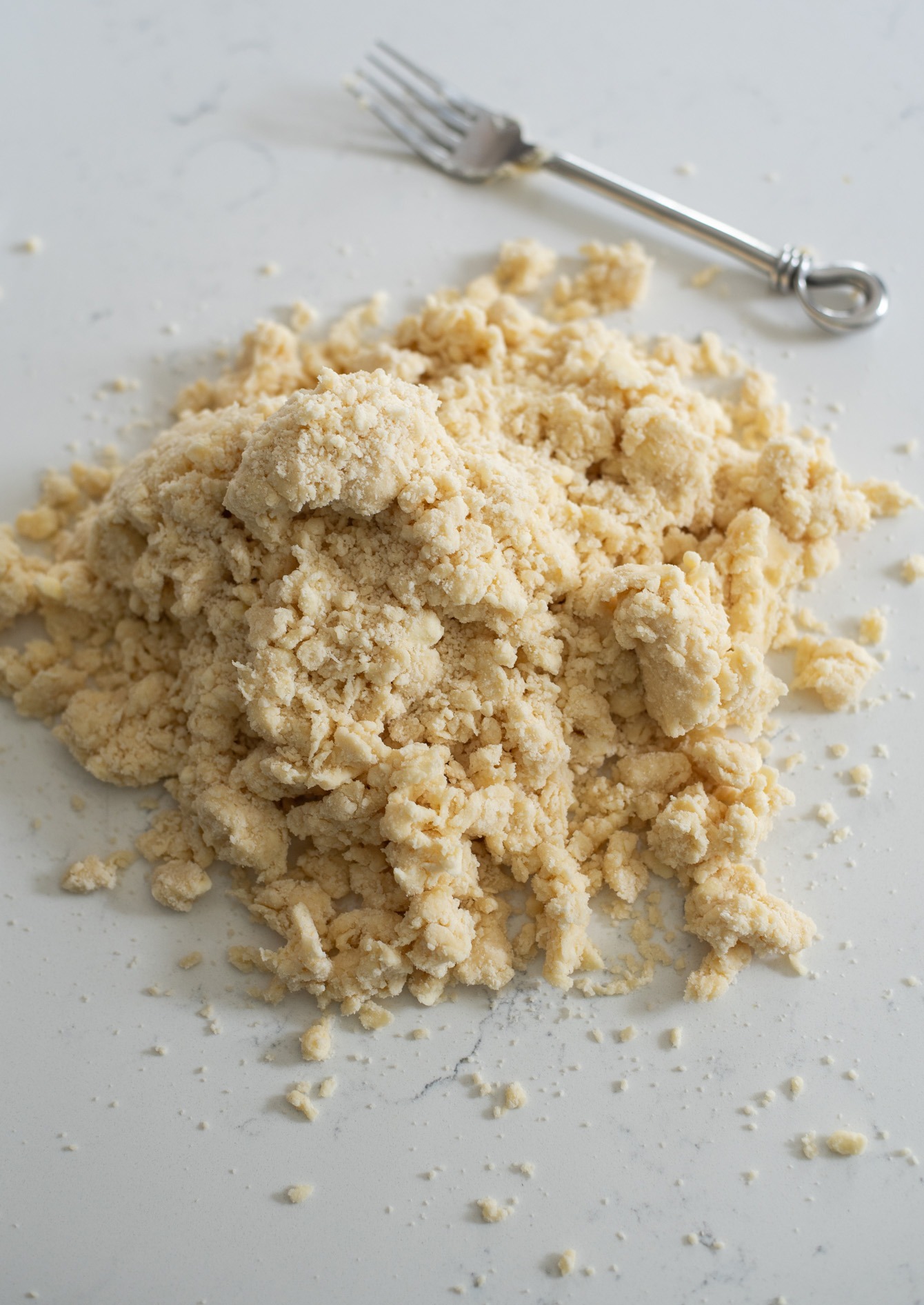
How to make Lard and Butter Pie Crust
Prepare your fat
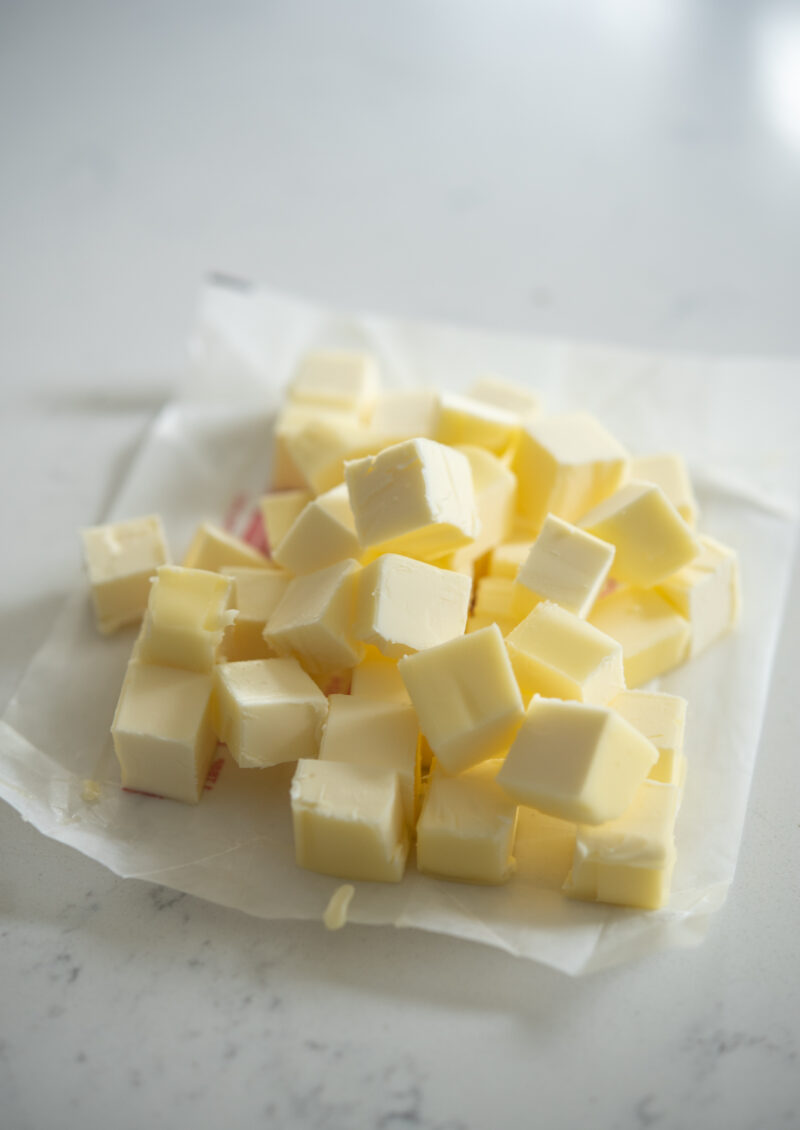
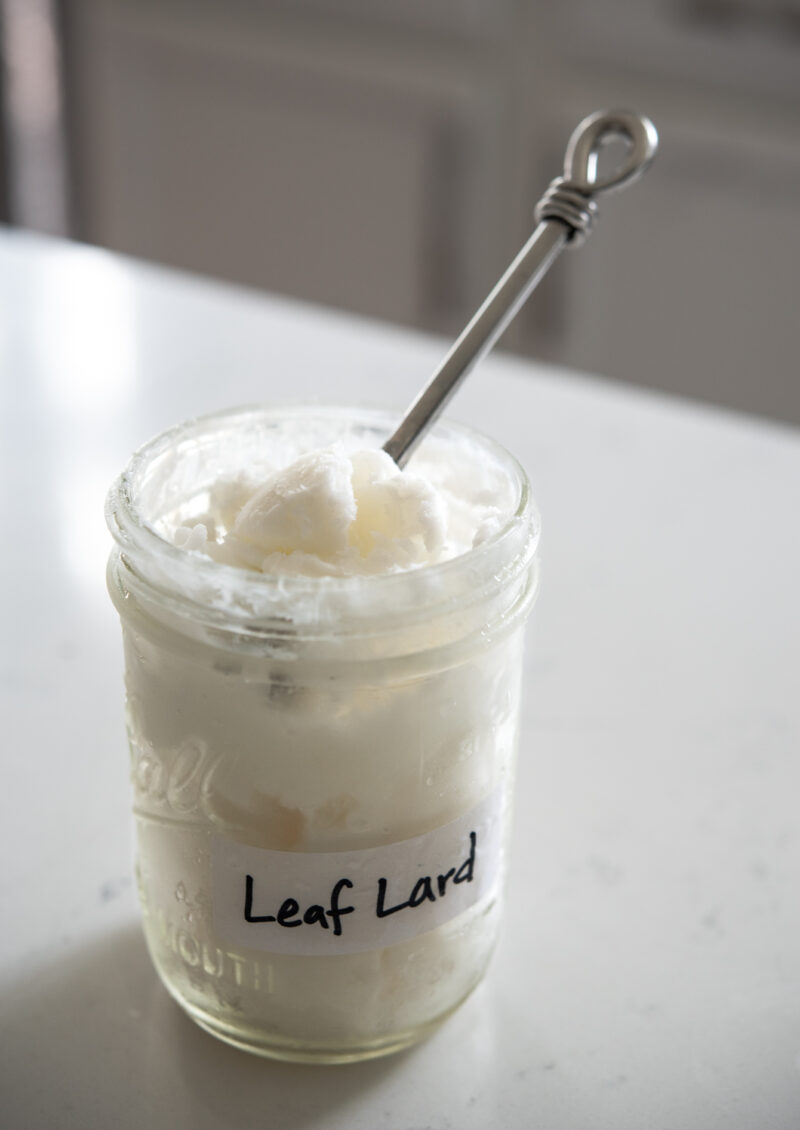
- Before you start, the lard and butter should be chilled and very cold. Cut the butter into 1/2-inch cubes.
- Scoop up the leaf lard by the tablespoonful or measure into 1/2 cup first, then scoop out. Add 2 more tablespoons.
Cut in the Fat
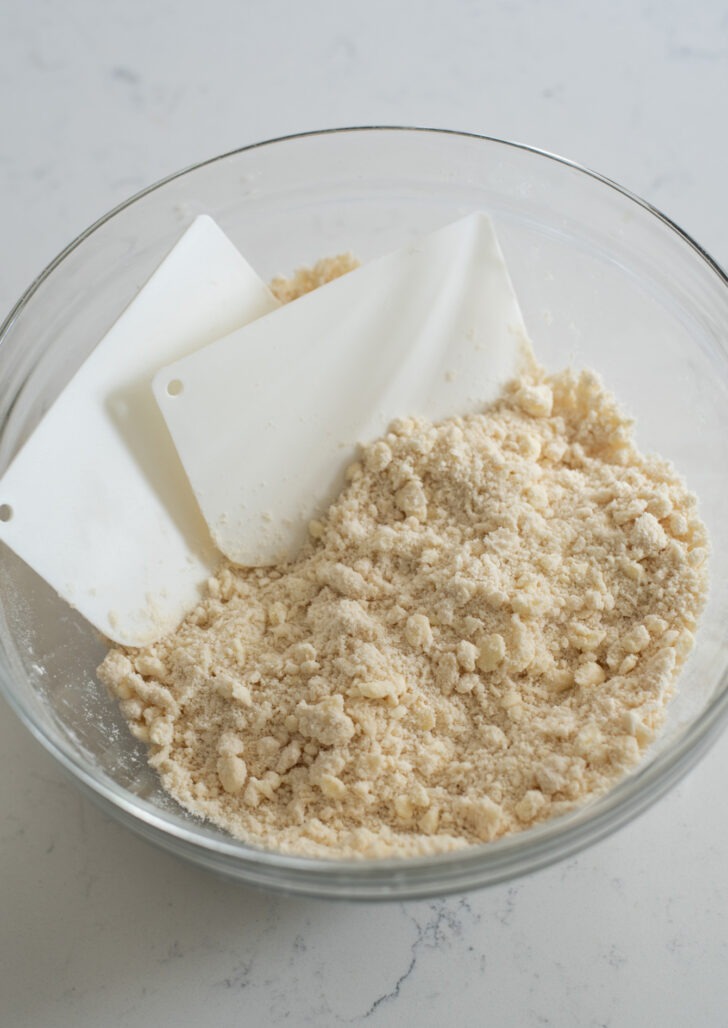
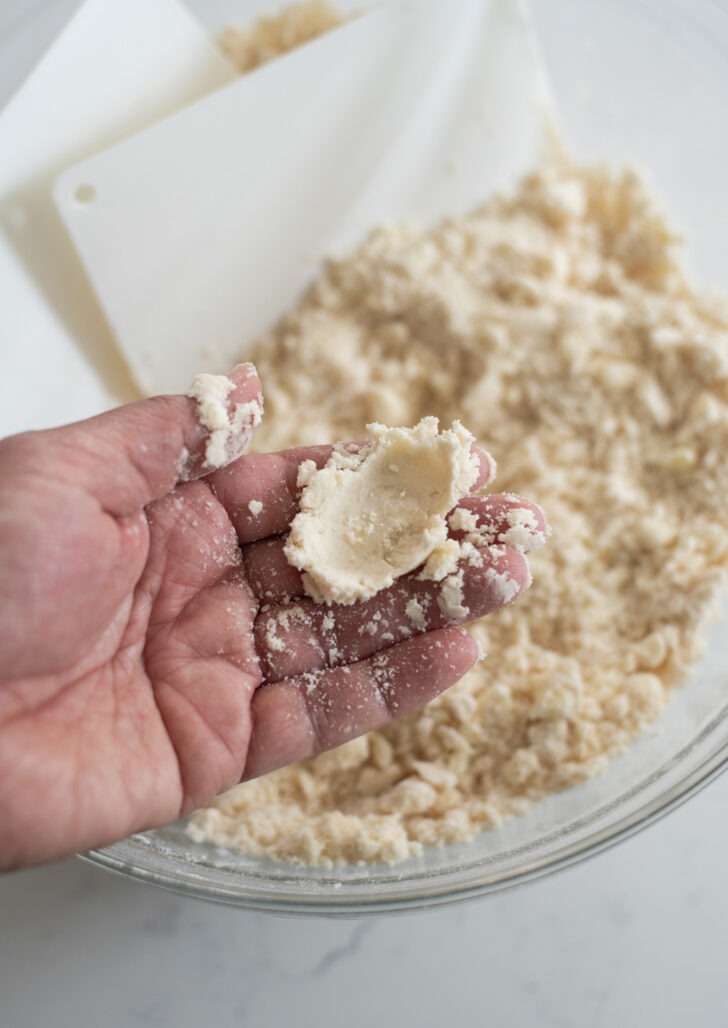
- Whisk together flour, cornstarch, salt in a large mixing bow. Add the chunks of leaf lard and butter pieces.
- Cut the fats in the flour using dough scrapers or a pastry blender until you get coarse crumbs, like the size of large peas.
- When you press the a small portion of mixture together with your fingers, it should hold the shape without falling apart.
Add the Liquid (Egg + Vinegar + Water)
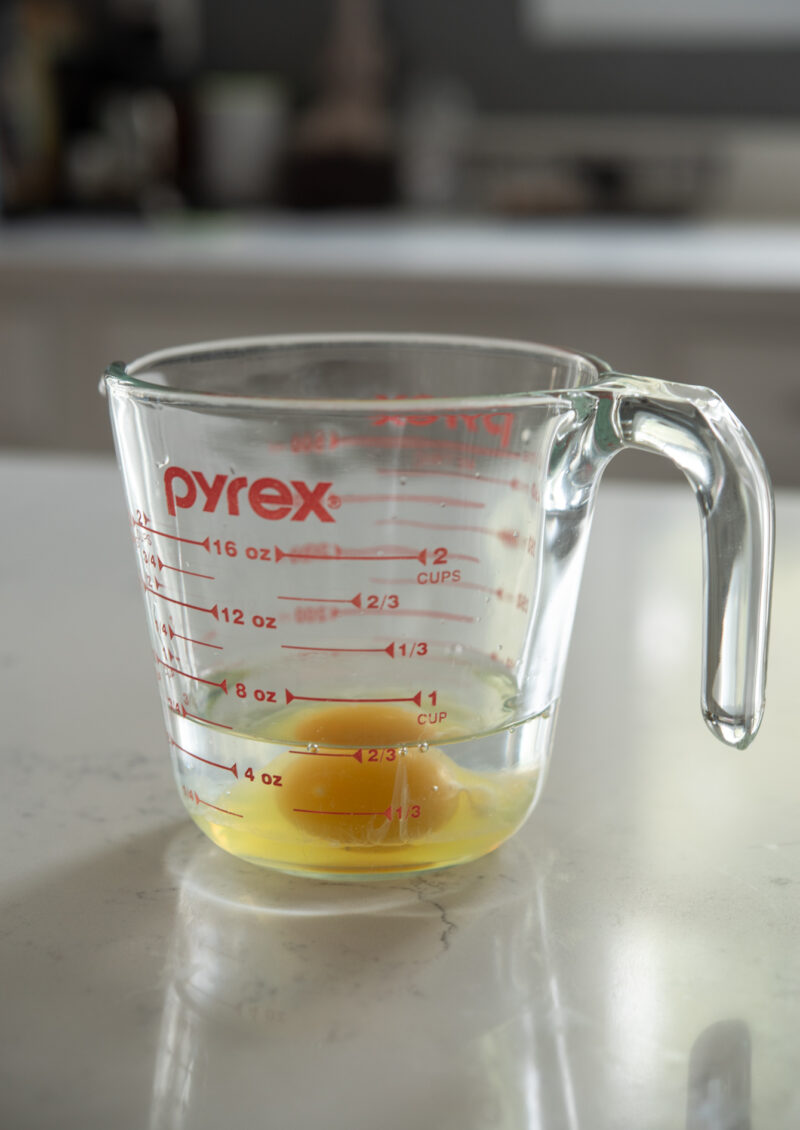
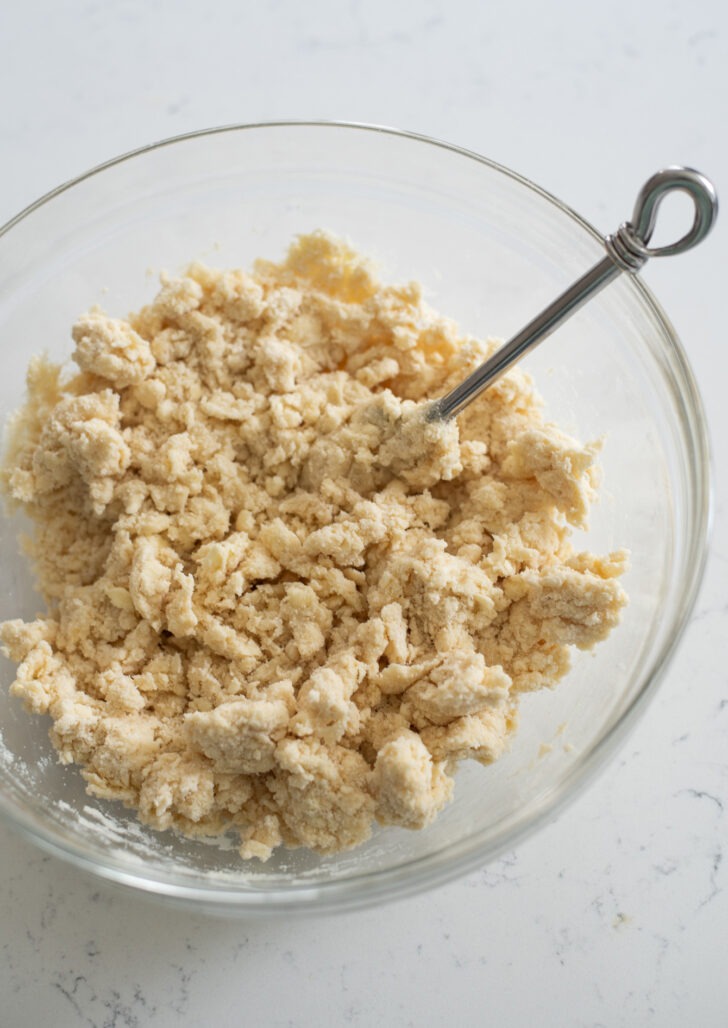
- Crack an egg in a glass measuring cup (2 cup size), and add vinegar. Pour cold ice water to measure the liquid to reach 2/3 cup amount. Beat well.
- Drizzle about 1/2 cup of liquid around the flour mixture and stir gently with a fork. Add more liquid on the dry spots in small amounts. You might not need the entire liquid – use just enough to moisten the mixture slightly.
- When the dough mixture is moistened without being too sticky or dry, dump it on a lightly floured surface.
Food Processor method: If you prefer to make the pie dough in a food processor, here’s how you do it.
- Put the dry ingredients in a large food processor fitted with the metal blade and pulse a few times to combine. Add the lard and cubed butter, and quick pulse 3-5 times until the fats are broken up into pieces the size of large peas.
- Slowly begin to add 1/2 cup of vinegar egg mixture first. While still pouring, run the food processor until all the liquid has been added. Add more liquid if needed. The mixture should begin to come together but stop before it forms a complete ball. Some crumbs are okay.
Gather and Shape the Dough
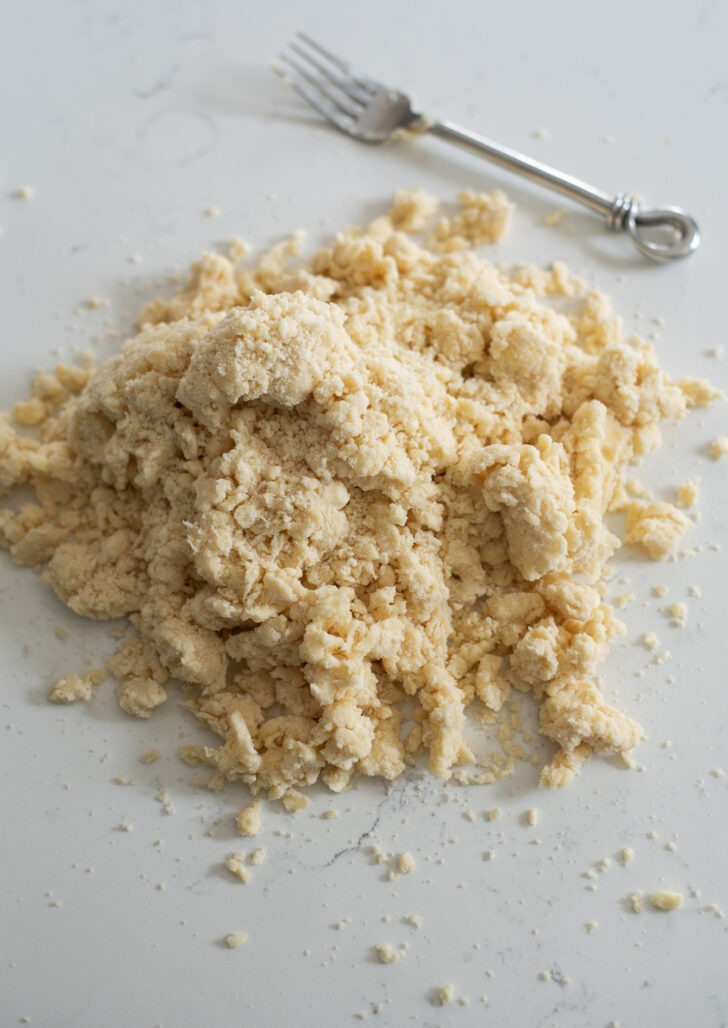
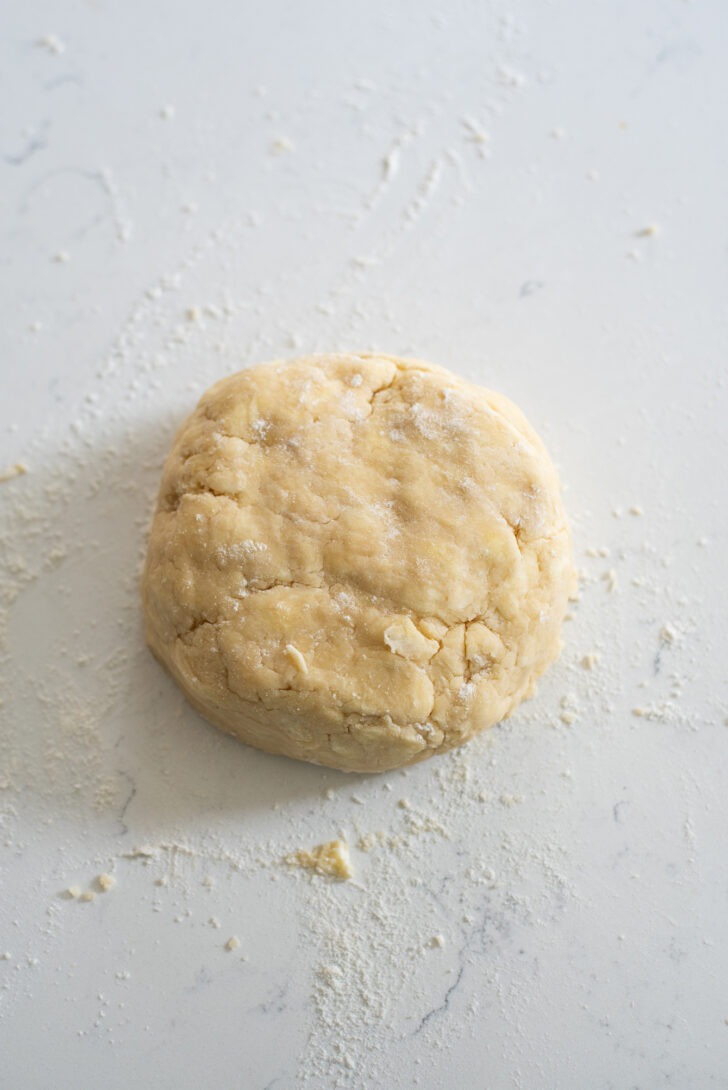
- When the dough mixture is moistened without being too sticky or dry, dump it on a lightly floured surface.
- Gather up the dough.
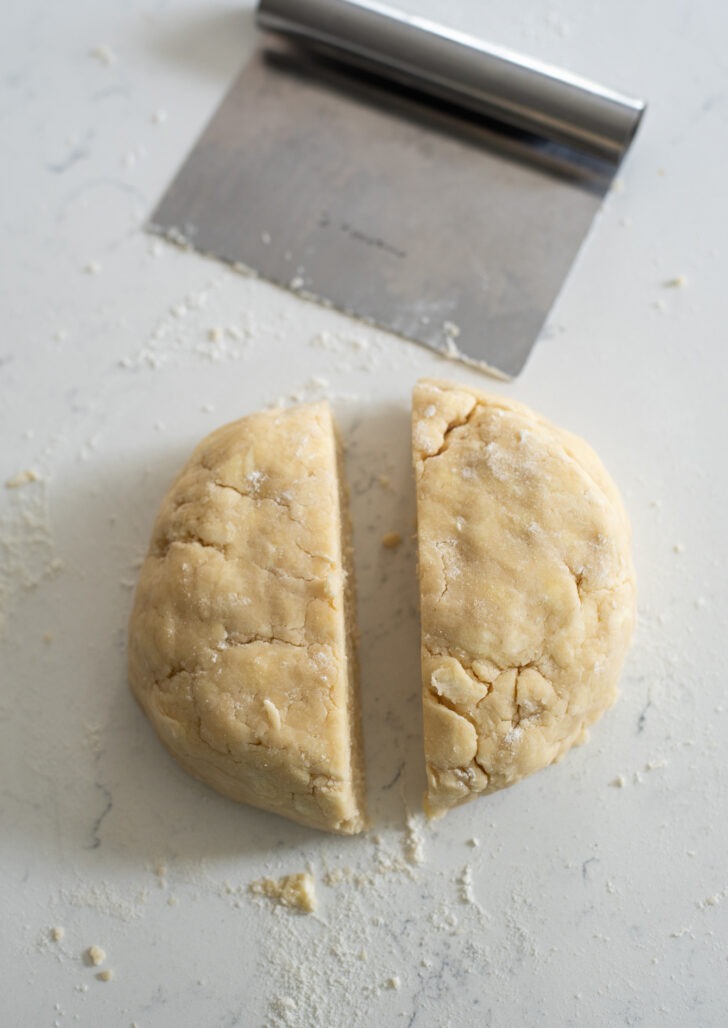
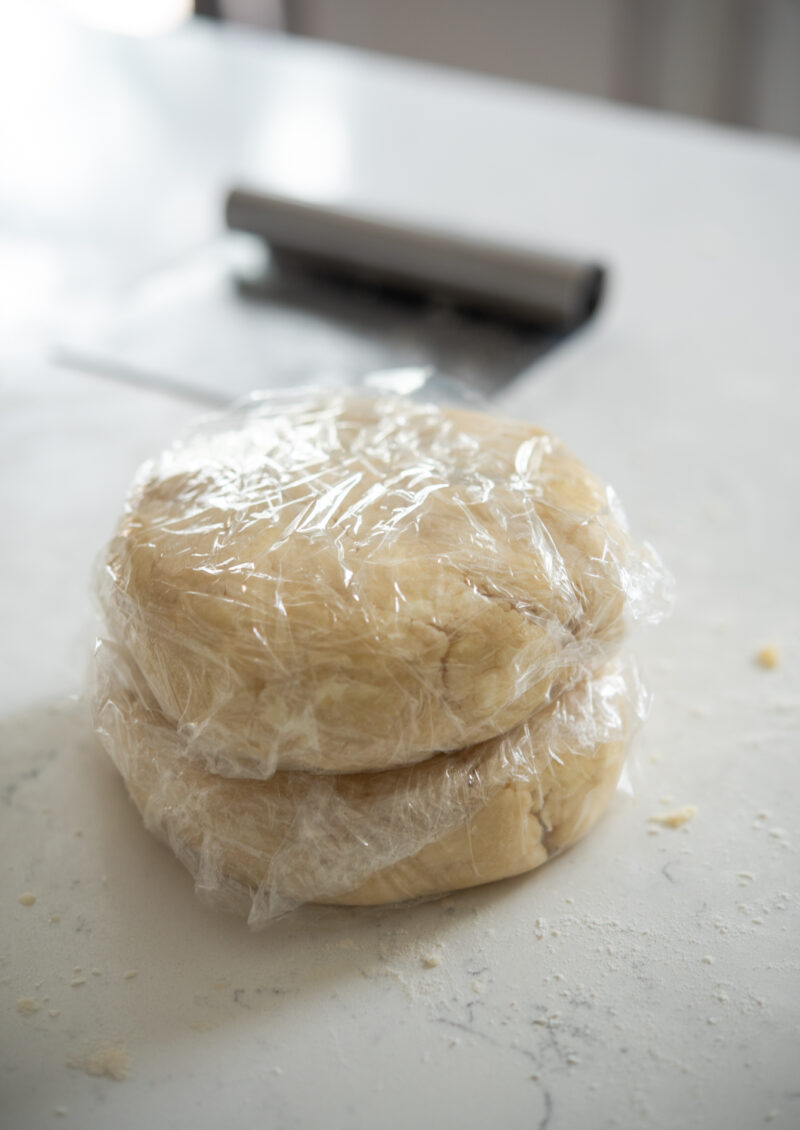
- Divide the dough in half. (If I am making a double crust pie, I usually make the bottom crust dough to be slightly larger than the top crust portion)
- Form each dough half into a disk and wrap with a piece of plastic wrap. Chill the dough for at least 1 hour before you roll out.
Rolling Out the Pie Dough
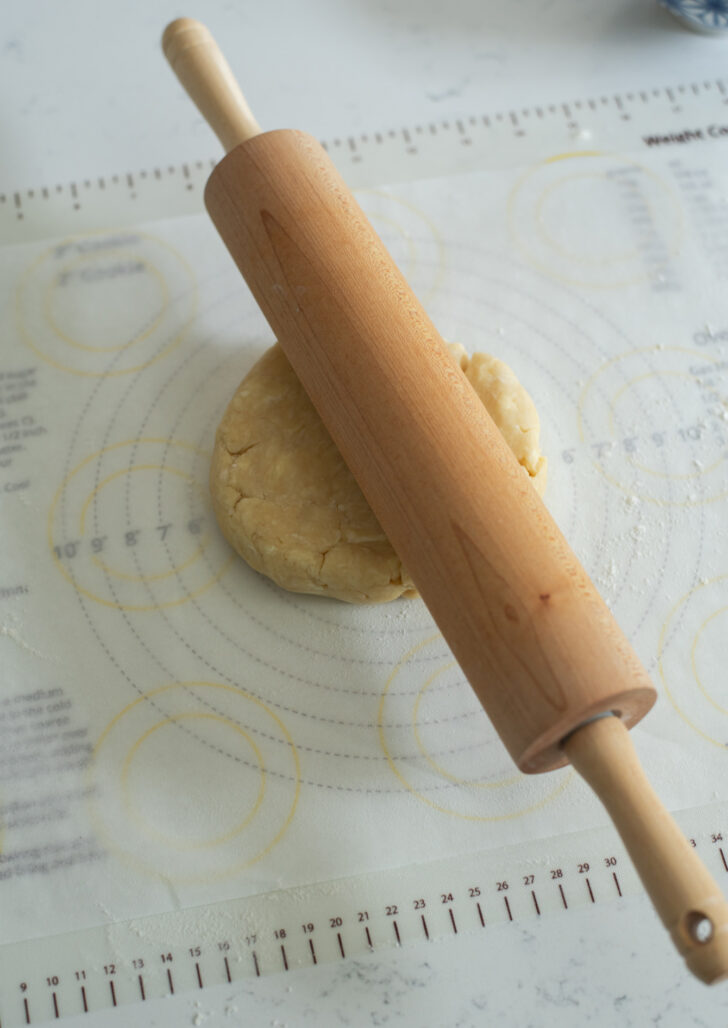
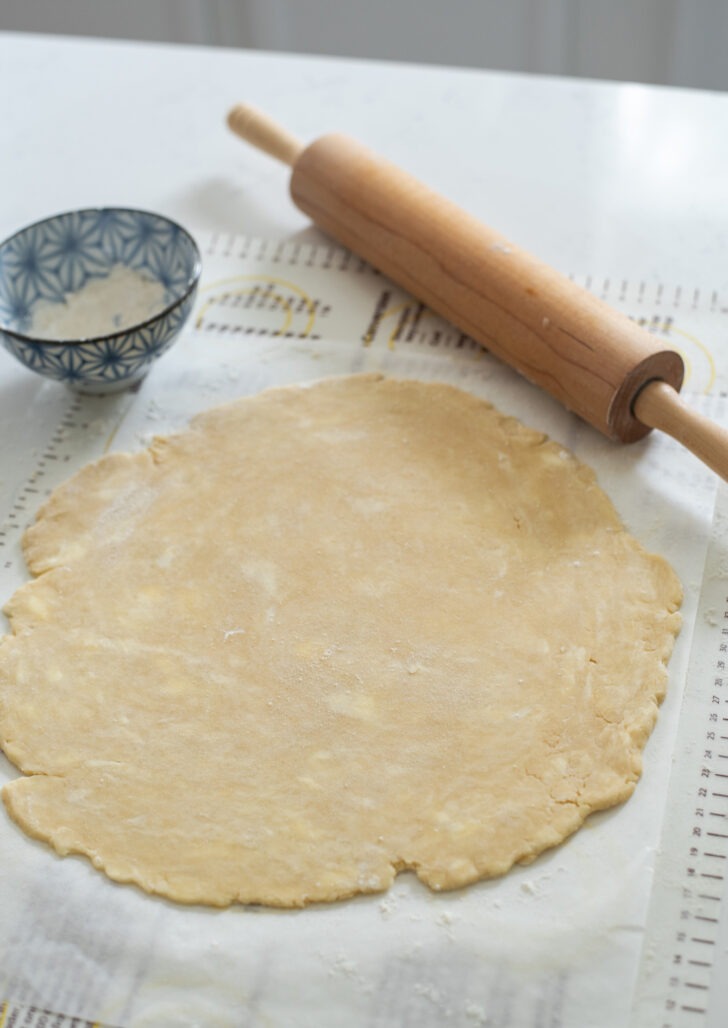
- Whack the pie dough with a rolling pin a few times if the dough seems too hard.
- Dust the surface with a little flour and start rolling the dough from the center out and rotating a quarter turn. Run your fingers under the dough to loosen it. Dust more flour if the dough feels sticking to the surface, but use as little as possible.
- Roll out into a circle until you get about 13-inchs in diameter. This will fit to a standard 9 or 9 1/2 inch pie pan.
Fluting the Edge of Pie Crust
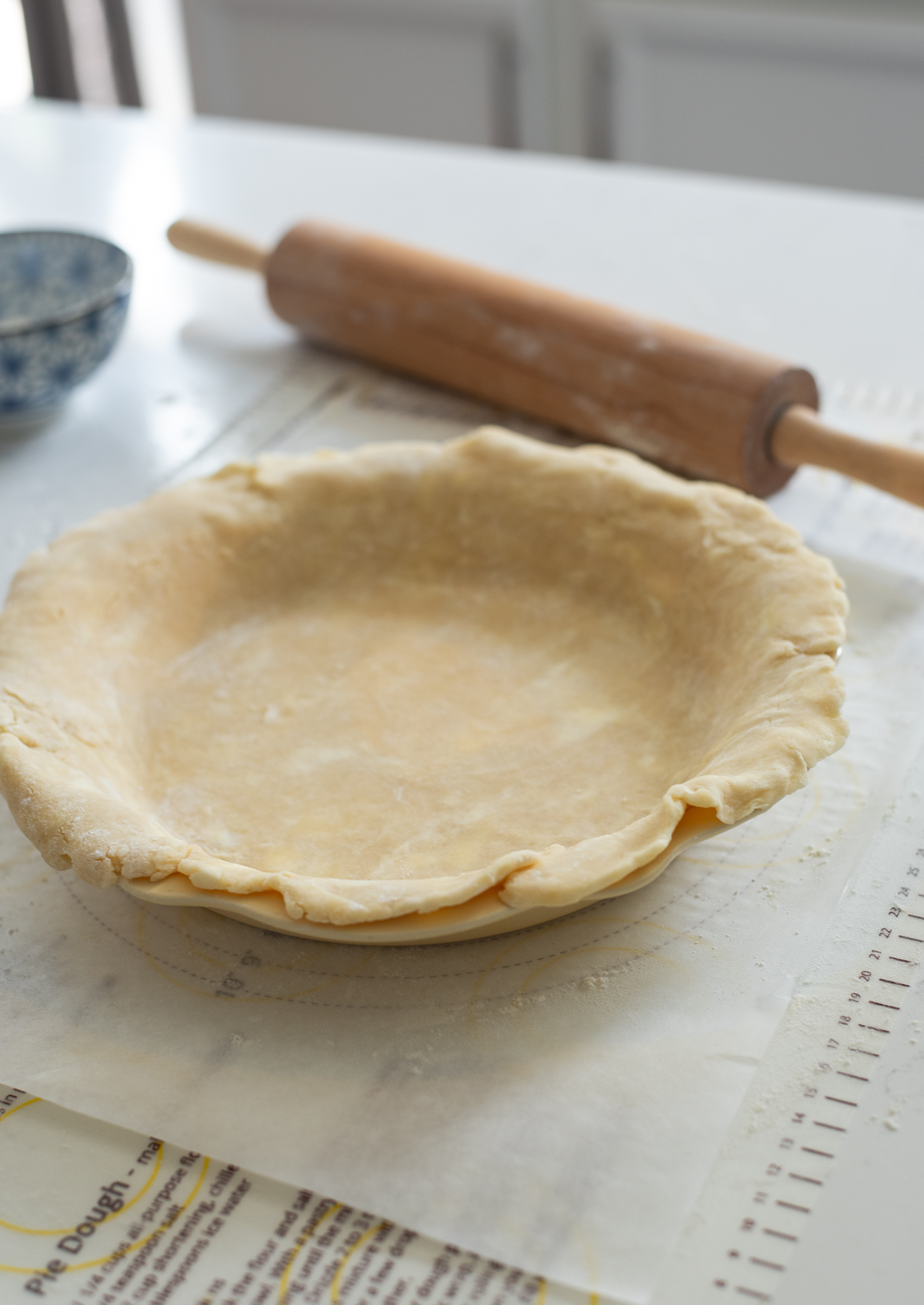
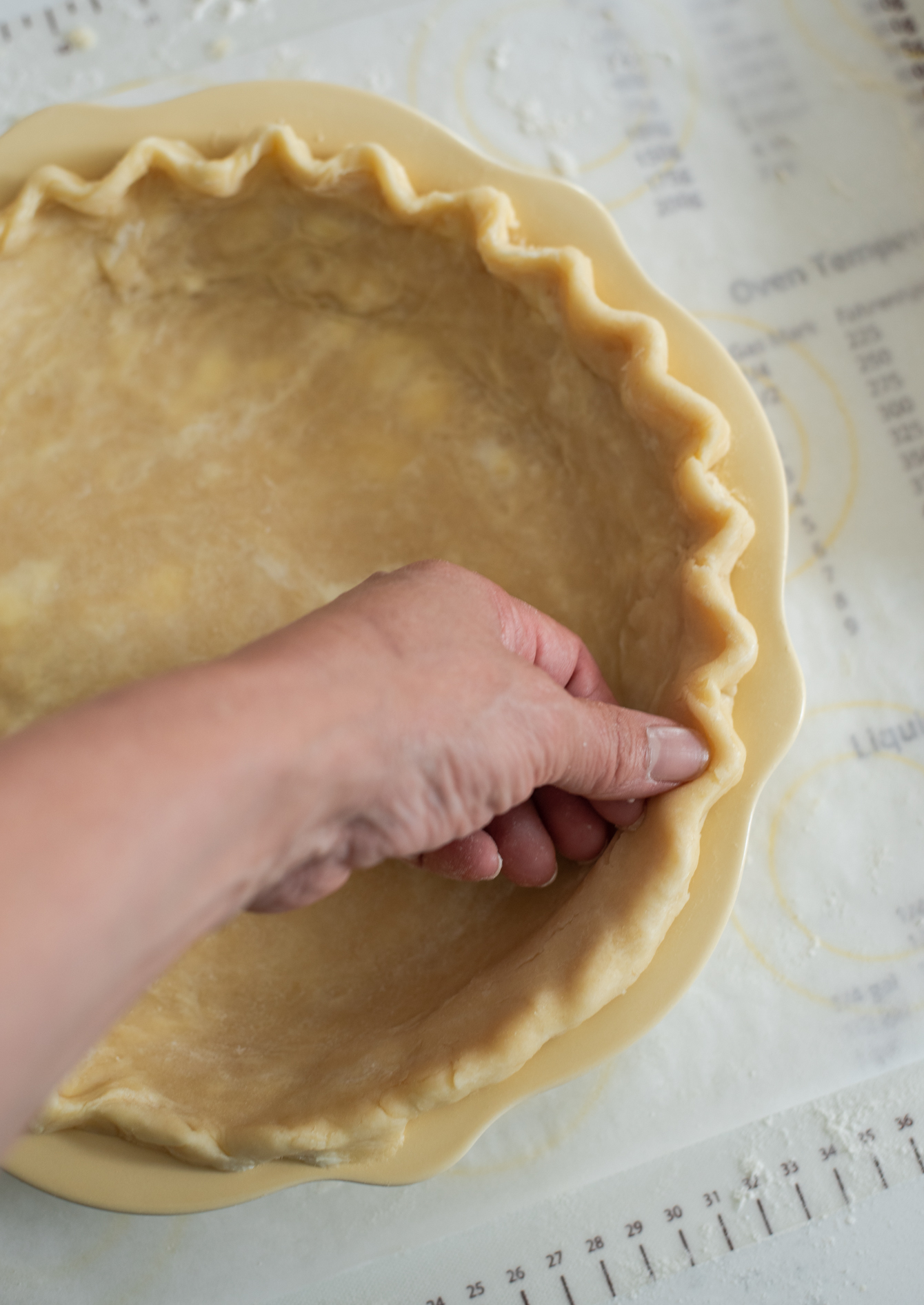
- Transfer the pastry to fit into a pan, gently nudging it down the sides of the pan.
- Lift up the overhanging dough and fold it under.
- Create the flute by using your thumb and forefinger to make a V pattern.
- Cover the pie shell with plastic wrap and refrigerate until ready to use.
How to par-bake (blind bake) pie crust
Line the bottom of the crust with foil or parchment paper, filling with pie weights (or dried beans or rice). Then bake the pie crust at 375˚F for 10 to 12 minutes. Remove the weights and let the crust cool until ready to use.
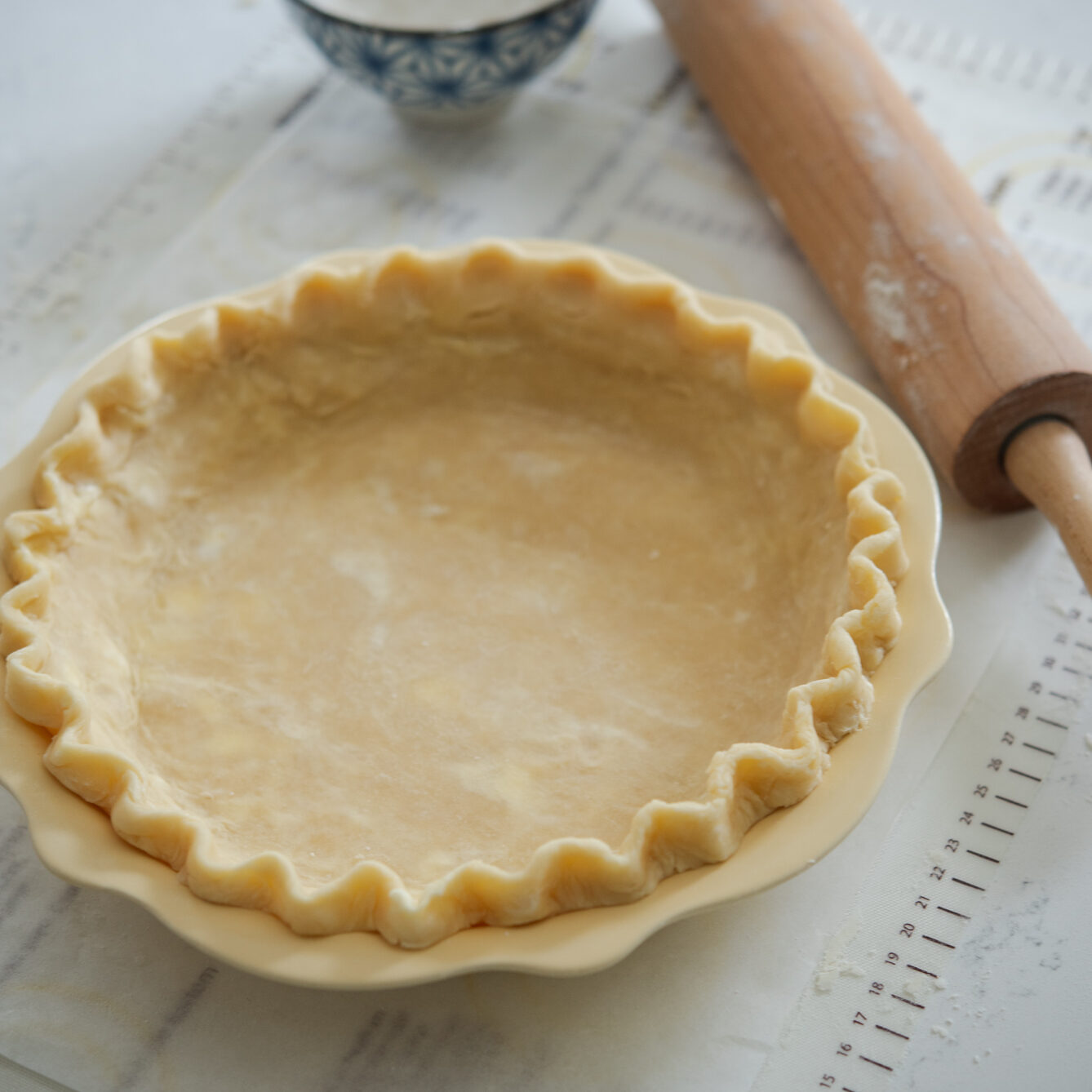
Storage and Freezing Tips
For pie dough
You can make the pie dough ahead of time and store in the refrigerator up to 1 week, or freeze up to 3 months. Make sure to wrap each dough with plastic wrap and put them in a zip bag.
To use, thaw your frozen pie dough in the refrigerator overnight before using. Then roll it out with rolling pan and use as a pie crust.
For pie crust
Roll out the pie crust and form it on a pie pan. Put the whole thing (both pie crust and pie pan) in a large freezer bag and freeze up to 3 months.
To use, thaw your frozen pie crust in a pan in the refrigerator overnight before using. Or take it out right before you add filling, and bake it a few minutes longer than recipe suggests.
Lard and Butter Pie Crust Recipe Video (Full Version)
Pies Recipes Using This Pie Crust
Are you a pie lover? Check out my pie recipes for awesome pie ideas. Here are a few pies that you can use this pie crust recipe with.
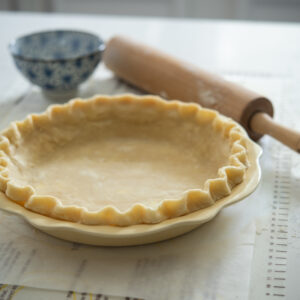
Light, Flaky Pie Crust with Lard and Butter
Recipe Video
Ingredients
- 3 cup (370 g) all-purpose flour
- 1 tbsp (7.5 g) cornstarch
- 1 tsp (5 g) salt
- 10 tbsp (128 g) leaf lard , or lard, chilled
- 8 tbsp (113 g) butter, chilled and cut into small cubes
- 1 large egg
- 1 tbsp (15 ml) white vinegar
- ice cold water
Equipment
Instructions
- Whisk together flour, cornstarch, salt in a large mixing bow. Add the leaf lard by the tablespoonful and butter cubes.
- Cut the fats in the flour using dough scrapers or a pastry blender until you get coarse crumbs. When you press the a small portion of mixture together with your fingers, it should hold the shape without falling apart.
- Crack an egg in a glass measuring cup (2 cup, about 480 ml, size), and add vinegar. Pour cold water to measure the liquid to reach 2/3 cup (158 ml) amount. Beat the mixture well.
- Drizzle about 1/2 cup (120 ml) of liquid around the crumb mixture and stir gently with a fork. Add a small amount of liquid on the dry spots and continue stirring until the mixture is slightly moistened. You may not need to use all of the liquid – use just enough to moisten the mixture slightly. Some crumbs are okay.
- When the dough mixture is moistened without being too sticky or dry, dump it on a lightly floured surface. Gather up the dough. Divide the dough in half. (If I am making a double crust pie, I usually make the bottom crust dough to be slightly larger than the top crust portion)
- Form each dough half into a disk and wrap with a piece of plastic wrap. Chill the dough for at least 1 hour before you roll out.
Rolling out and fluting pie crust
- Whack the pie dough with a rolling pin a few times if the dough seems too hard. Dust the surface with a little flour and start rolling the dough from the center out and rotating a quarter turn. Run your fingers under the dough to loosen it. Dust more flour if the dough feels sticking to the surface, but use as little as possible.
- Roll out into a circle until you get about 13-inches (33 cm) in diameter. This will fit to a standard 9 or 9 1/2 inch (23 cm) pie pan.
- Transfer the pastry to fit into a pan, gently nudging it down the sides of the pan. Lift up the overhanging dough and fold it under. Create the flute by using your thumb and forefinger to make a V pattern. Cover the pie shell with plastic wrap and refrigerate until ready to use.
Notes
- Put the dry ingredients in a large food processor fitted with the metal blade and pulse a few times to combine. Add the lard by the tablespoonful and cubed butter, and quick pulse 3-5 times until the fats are broken up into pieces the size of large peas.
- Slowly begin to add 1/2 cup of vinegar egg liquid mixture first. While still pouring, run the food processor until all the liquid has been added. Add more liquid if needed. The mixture should begin to come together but stop before it forms a complete ball. Some crumbs are okay.

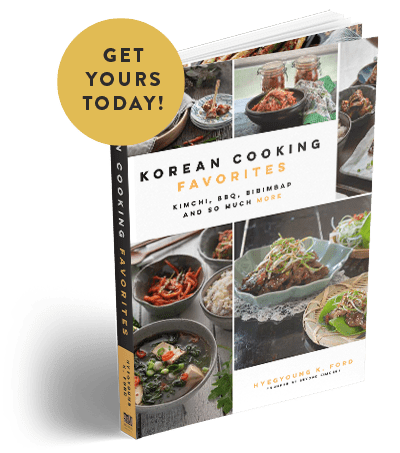
Hi Holly. I am making a pie crust for the first time ever, so I watched the video as well as read all your notes and comments. I am confused about one thing though. The recipe states 10 tbsp lard and 8 tbsp butter, but the video says the opposite..8 lard and 10 butter. Which should I follow?
Use 8 tbsp of butter and 10 tbsp of lard. I made a mistake in the video, and it was too late to fix it after uploading. I hope you enjoy this pie crust. Thanks!
Thank you so much for this recipe! I’ve been trying to improve my pie crust without using crisco for years. This recipe does the trick.
The crust is great, but I found that it must be baked with weights for 15-20min; then remove beans/weights and return to oven for another 15 or the bottom crust will be under-cooked.
I made lemon meringue and chocolate fudge pudding pies which this crust really compliments.
Can this be made ahead and frozen baked later?
Certainly! You can either freeze the pie dough as is, or roll it out and form it in the pan before freezing. You’ll find the instructions in the post content. Thank you!
Fantastic pastry, thank you! This will be my go to from now on.
Thrilled to know you love this pastry! Enjoy your pie-making journey! Thanks for the comment.
This recipe looks great and I am anxious to try it…can I substitute gluten free flour?
Hi Tamie
I have not tried with gluten free flour but I think it should work. Hope it works out for you. Let me know how it turns out. Thanks.
Hi Holly,
I have a question… I do not eat pork… is there an alternative to lard… would crisco work?
Hi Pocho
You can use vegetable shortening instead of pork lard. That’s is perfectly fine. Hope you like this recipe. Thank you.
Hi Holly! I’m so glad I found your amazing pie crust recipe. I made it last night. It is truly the best I’ve ever made or eaten. Excellent! I’m going to make a few and freeze them. Can’t wait to check out your other recipes. 🙂
Hi Sherrie
Thanks for visiting my site. I am so glad that you loved my pie crust recipe. Hope you get to find more delicious recipes in my site to try. Don’t hesitate to ask if you have any questions.
Thank you!
Have yet to make but sounds good.. What about baking instruction pre-cooked crust being added to the recipe please?
Hi Corinne
I added a tip on how to par-bake (blind bake) the pie crust in the post. Hope it helps. Thanks.
This recipe is awesome! I have always made Pioneer Woman’s pie crust and they don’t compare. This recipe is definitely more flaky and the tasty. My husband and dad loved the crust! This will be my pie crust recipe I will use forever. Thanks for sharing it.
Loved this recipe.! It made enough for 3 pie crust. It was easy to roll out and it created a flaky crust. Highly recommend.
We love the combo of lard and butter in pie crusts. This looks great — thanks.